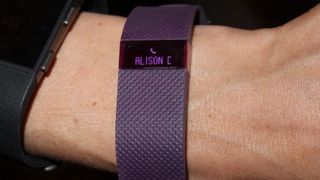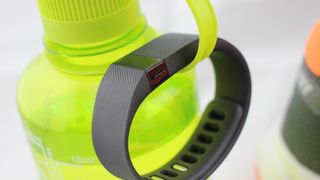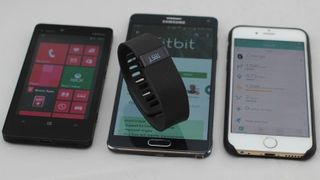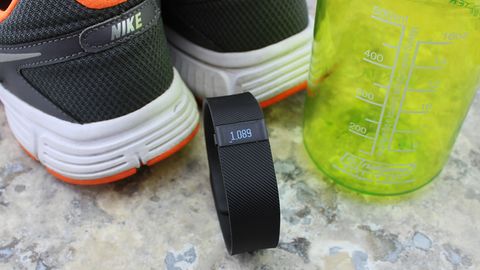Why you can trust TechRadar
Call notifications
I exclusively tested the unreleased Fitbit Force Caller ID firmware update that was supposed to be released post-launch and, of course, never made it out of Fitbit's offices.
Fitbit Charge debuts this long-overdue smartwatch-like feature, and it lives up to the promise or providing call notifications one year later.

Incoming calls on Fitbit Charge-tied smartphone display the name of your contact on the wearable, flashing and scrolling their full name across the always-too-short OLED.
The wristband doesn't sound because there's no speaker, but it does vibrate and promptly got my attention. And, really, if someone is calling instead of texting me these days, it's usually important.
Fitbit Charge's Caller ID feature actually saved me from missing two calls over the course of two weeks because my phone was charging in another room and set to vibrate.
It was a bit of a shock, because my brain knew I wasn't wearing a smartwatch and certainly not close to the commemorative 10,000 steps that happens when you reach that goal. My brain adjusted and was thankful for the interruption as I took the call on the phone.
Battery life
There's a lot going on with Fitbit Charge's new call notification and automatic sleep tracking feature in addition to usual steps and other exercise tracking.
In my two-week trial, the battery life remained the same: typically seven to eight days between charges, even with the "all-day syncing" option turned on in the app.

That falls within Fitbit's promised seven to ten day charging period and is comparable among other fitness bands with wireless syncing that are currently available.
The proprietary USB charging cable is still too short, easy to lose and doesn't work with other devices besides Fitbits.
At least I now have two of them thanks to the retired Fitbit Force that I'm no longer need to review. It's slowly trying to become the iPhone lighting cable of fitness chargers.
Compatibility
Fitbit Charge works with over 120 devices smartphones and it's one of the few fitness tracking brands to support iOS, Android and Windows Phone.

Only recently did Jawbone Up24 enter this rarified territory by adding a Windows Phone app in September, and the new Microsoft Band of course brings compatibility on all platforms.
Well, almost on all platforms. Fitbit isn't forking over its data so that it can be used in Apple's iOS 8 Health app, which could be a bummer for some iPhone 6 and iPhone 6 Plus owners who are looking for the best iPhone Health apps.
Overall, Fitbit Charge works with more devices and that's meaningful for not only you but also your other-device-owning friends you want to convince to join the race for steps and badges.
We liked
The best way to put an easy-to-read pedometer on your wrist is by buying the Fitbit Charge. It includes all of the basic stats you need whether you're running or milling about the house and want to ensure you get enough daily movement. The app and website sync with the wearable to go beyond the tiny OLED with even more insight over time.
New extras like automatic sleep tracking and caller ID join existing favorite features like the silent alarms and badges in friendly competitions. Fitbit Charge is already a good motivator and being able to rival your Fitbit-owning friends brings the fitness challenge to a new level.
We disliked
Fitbit Charge isn't as stylish as the Jawbone Up24 bracelet design and doesn't have the unique dot matrix display found in the Nike FuelBand SE. Its textured style can't compare, especially in the currently limited black and shale colors.
By the time the blue and burgundy come out the Fitbit Charge HR and Fitbit Surge, both with more secure wristwatch buckle clasps, are going to be ready for their early 2015 release date. Fitbit even beta tested them a little early at the end of 2014.
I'm not warming up to the sleep tracking that's still all over the place, and only beginning to become okay with the proprietary USB cable method of charging simply because I already own one. Anyone buying a wrist-worn Fitbit for the first time is going to want very careful with the small, easy-to-lose cable.

Final Verdict
Fitbit Charge picks up on where Fitbit Force left us too soon, and it really leads the hunt for quantified self in a lot of areas. It's small, comfortable and has a subtle OLED display. It's certainly not a smartwatch, even though it now boasts the convenience of incoming call notifications, and that's part of its fitness-focused charm.
No, it's not as hip looking as the Jawbone Up24, but it tracks, steps, calories burned, distance traveled and flights of stairs climbed and all of that can be seen right on the device. That's much easier for the fitness-conscious among us who like to check stats from the hip. It's especially relevant for the older generation that isn't always syncing to their smartphone.
Jawbone Up 3 is about to release and I'm curious as to how the follow-up to my favorite fitness and sleep tracker performs next to the Fitbit Charge. It'll be much more expensive, as will the heart-rate-monitoring Fitbit Charge HR and Fitbit Surge "superwatch." The Fitbit Charge has no heart-rate-monitoring but it has heart when it comes to being the best fitness tracker with all the basics for its price range. I'll update this review as the race thickens.
Current page: Caller ID, battery life, compatibility and verdict
Prev Page Interface, accuracy, sleep tracking

